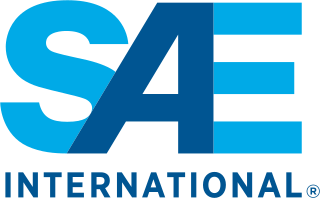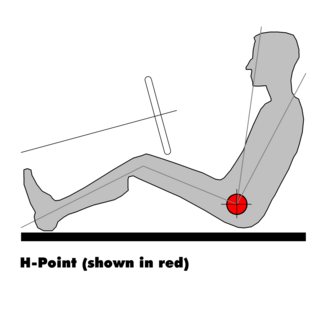Related Research Articles

SAE International is a global professional association and standards organization based in Warrendale, Pennsylvania, United States. Formerly the Society of Automotive Engineers, the organization adopted its current name in 2006 to reflect both its international membership and the increased scope of its activities beyond automotive engineering and the automotive industry to include aerospace and other transport industries, as well as commercial vehicles including autonomous vehicles such as self-driving cars, trucks, surface vessels, drones, and related technologies.
The National Highway Traffic Safety Administration is an agency of the U.S. federal government, part of the Department of Transportation, focused on transportation safety in the United States.
Type approval or certificate of conformity is granted to a product that meets a minimum set of regulatory, technical and safety requirements. Generally, type approval is required before a product is allowed to be sold in a particular country, so the requirements for a given product will vary around the world. Processes and certifications known as type approval in English are often called homologation, or some cognate expression, in other European languages.

The World Forum for Harmonization of Vehicle Regulations is a working party (WP.29) of the Inland Transport Committee (ITC) of the United Nations Economic Commission for Europe (UNECE). Its responsibility is to manage the multilateral Agreements signed in 1958, 1997 and 1998 concerning the technical prescriptions for the construction, approval of wheeled vehicles as well as their Periodic Technical Inspection and, to operate within the framework of these three Agreements to develop and amend UN Regulations, UN Global Technical Regulations and UN Rules, kind of vehicle regulation.
The automotive industry in India is the world's fourth-largest by production and valuation as per 2022 statistics. As of 2023, India is the 3rd largest automobile market in the world in terms of sales.
The Society of Motor Manufacturers and Traders (SMMT) is the trade association for the United Kingdom motor industry. Its role is to "promote the interests of the UK automotive industry at home and abroad."
Vehicle regulations are requirements that automobiles must satisfy in order to be approved for sale or use in a particular country or region. They are usually mandated by legislation, and administered by a government body. The regulations concern aspects such as lighting, controls, crashworthiness, environment protection and theft protection, and might include safety belts or automated features.
Government regulation in the automotive industry directly affects the way cars look, how their components are designed, the safety features that are included, and the overall performance of any given vehicle. As a result, these regulations also have a significant effect on the automotive business by generally increasing production costs while also placing limitations on how cars are sold and marketed. Automotive regulations are designed to benefit the consumer and protect the environment, and automakers can face stiff fines and other penalties if they are not followed.

The H-point is the theoretical, relative location of an occupant's hip: specifically the pivot point between the torso and upper leg portions of the body—as used in vehicle design, automotive design and vehicle regulation as well as other disciplines including chair and furniture design.
Motor vehicle type approval is the method by which motor vehicles, vehicle trailers and systems, components and separate technical units intended for such vehicles achieve type approval in the European Union (EU) or in other UN-ECE member states. There is no EU approval body: authorized approval bodies of member states are responsible for type approval, which will be accepted in all member states.
Bharat stage emission standards (BSES) are emission standards instituted by the Government of India to regulate the output of air pollutants from compression ignition engines and Spark-ignition engines equipment, including motor vehicles. The standards and the timeline for implementation are set by the Central Pollution Control Board under the Ministry of Environment, Forest and Climate Change.

Automotive Research Association of India (ARAI) is a co-operative industrial research association by the automotive industry with the Ministry of Heavy Industries and the Government Of India. The objectives of the Association are Research and Development in automotive engineering for industry, product design and development, evaluation of automotive equipment and ancillaries, standardisation, technical information services, execution of advanced courses on the application of modern technology and conduct of specific tests.
National Automotive Testing and R&D Infrastructure Project (NATRiP), the largest and one of the most significant initiatives in automotive sector so far, represents a unique joining of hands between the Government of India, a number of state governments and Indian Automotive Industry to create a state of the art Testing, Validation and R&D infrastructure in the country.

The Alliance for Automotive Innovation (AAI) is a Washington, D.C.-based trade association and lobby group whose members include international car and light duty truck manufacturers that build and sell products in the United States.

People who are driving as part of their work duties are an important road user category. First, workers themselves are at risk of road traffic injury. Contributing factors include fatigue and long work hours, delivery pressures, distractions from mobile phones and other devices, lack of training to operate the assigned vehicle, vehicle defects, use of prescription and non-prescription medications, medical conditions, and poor journey planning. Death, disability, or injury of a family wage earner due to road traffic injury, in addition to causing emotional pain and suffering, creates economic hardship for the injured worker and family members that may persist well beyond the event itself.
The Bharat New Car Assessment Program, usually known as the Bharat NCAP, is the official New Car Assessment Program for India. Cars sold in the country will be assigned by star ratings based on their safety performance. It was implemented in phases, according to the plans drawn up by the National Automotive Testing and R&D Infrastructure Project. It is the 10th NCAP in the world and was set up by the government of India.

The Motor Vehicles Act is an Act of the Parliament of India which regulates all aspects of road transport vehicles. The Act provides in detail the legislative provisions regarding licensing of drivers/conductors, registration of motor vehicles, control of motor vehicles through permits, special provisions relating to state transport undertakings, traffic regulation, insurance, liability, offences and penalties, etc. For exercising the legislative provisions of the Act, the Government of India made the Central Motor Vehicles Rules 1989.
Vehicle weight is a measurement of wheeled motor vehicles; either an actual measured weight of the vehicle under defined conditions or a gross weight rating for its weight carrying capacity.
Automotive Industry Standard 140, commonly known as AIS 140, is a set of standards formulated and published by Automotive Research Association of India (ARAI) as per the order issued by the Automotive Industry Standards Committee (AISC) of Ministry of Road Transport and Highways. These standards are formulated to build and maintain an intelligent transportation system in India.
Regulation of self-driving cars, autonomous vehicles and automated driving system is an increasingly relevant topic in the automotive industry strongly related to the success of the actual technology. Multiple countries have passed local legislation and agreed on standards for the introduction of autonomous cars.
References
- ↑ "AIS Standards". Automotive Research Association of India. Retrieved 25 January 2015.
- ↑ "Society of Indian Automobile Manufactures". www.siam.in. Retrieved 19 September 2023.
- ↑ "Regulatory Framework". Archived from the original on 2011-01-27. Retrieved 2011-02-02.
- ↑ "Reference at www.indialawjournal.com".
- ↑ "Automotive Research And Development, Automotive Service Provider, India, Vehicle Type Certification, Automotive Testing And Calibration, Vehicle Design Labs, Advanced Automotive Design Standards, Automotive Engineering Course" (PDF).
- ↑ https://www.deccanherald.com/business/deadline-to-meet-battery-safety-norms-likely-to-be-extended-report-1145977.html
- ↑ "India is now the 4th largest auto market, overtakes Germany » MotorOctane". 24 March 2018.
- ↑ "Global status report on road safety 2018". www.who.int. Retrieved 2021-08-03.
- ↑ "Reference at www.carsafetyrules.com".
- ↑ "Reference at www.globalncap.org".
- ↑ "Tata Nano, other Indian small cars fail independent crash tests".
- ↑ "Alto K10 scores zero in crash test - ZigWheels".
- ↑ WHO, ed. (2015). "WHO Global status report on road safety 2015 (data table A2)" (official report). Geneva, Switzerland: World Health Organisation (WHO). Archived from the original (PDF) on November 30, 2015. Retrieved 2016-01-26.
- ↑ "Reference at www.who.int" (PDF).
- ↑ "The ugly side of India's automotive boom : Car-Nama". Archived from the original on 2013-03-06. Retrieved 2013-08-17.
- ↑ "Road safety: India needs to raise the bar - Rediff.com".